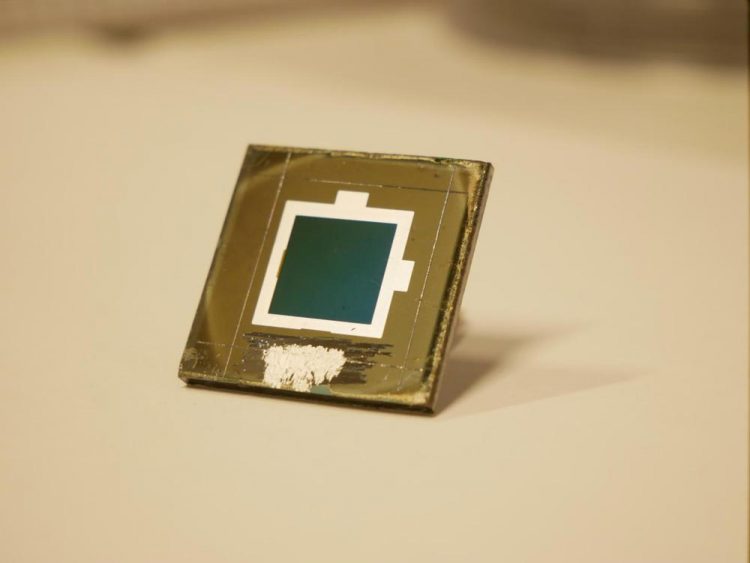Tandem solar cell world record: New branch in the NREL chart

The CIGS-Pero tandem cell was realised in a typical lab size of 1 square centimeter. Credit: HZB
CIGS cells, which consist of copper, indium, gallium and selenium, can be deposited as thin-films with a total thickness of only 3 to 4 micrometers; the perovskite layers are even much thinner at 0.5 micrometers.
The new tandem solar cell made of CIGS and perovskite thus has a thickness of well below 5 micrometers, which would allow the production of flexible solar modules.
“This combination is also extremely light weight and stable against irradiation, and could be suitable for applications in satellite technology in space”, says Prof. Dr. Steve Albrecht, HZB. These results, obtained in a big collaboration, have been just published in the renowned journal JOULE.
“This time, we have connected the bottom cell (CIGS) directly with the top cell (perovskite), so that the tandem cell has only two electrical contacts, so-called terminals”, explains Dr. Christian Kaufmann from PVcomB at HZB, who developed the CIGS bottom cell with his team and he adds “Especially the introduction of rubidium has significantly improved the CIGS absorber material”.
Albrecht and his team have deposited in the HySPRINT lab at HZB the perovskite layer directly on the rough CIGS layer. “We used a trick that we had previously developed,” explains former postdoc from Albrecht's group Dr. Marko Jošt, who is now a scientist at the University of Ljubjana, Slovenia. They applied so-called SAM molecules to the CIGS layer, which form a self-organised monomolecular layer, improving the contact between perovskite and CIGS.
The new perovskite CIGS tandem cell achieves an efficiency of 24.16 percent. This value has been officially certified by the CalLab of the Fraunhofer Institute for Solar Energy Systems (ISE).
Since such “2 Terminal” tandem cells made of CIGS and perovskite now represent a separate category, the National Renewable Energy Lab NREL, USA, has created a new branch on the famous NREL chart for this purpose.
This chart shows the development of efficiencies for almost all solar cell types since 1976. Perovskite compounds have only been included since 2013 – the efficiency of this material class has increased more steeply than any other material.
###
Prof. Dr. Steve Albrecht heads a BMBF-funded junior research group at HZB and is a junior professor at the Technical University of Berlin. Dr. Christian Kaufmann heads a research group at HZB's PVcomB. Recently, several world records for tandem solar cells made of perovskite in combination with inorganic semiconductors have been reported from HZB.Currently, Albrecht's team also holds the world record for tandem cells made of silicon and perovskite with 29.1 percent, which is also listed in the NREL charts.
Media Contact
All latest news from the category: Power and Electrical Engineering
This topic covers issues related to energy generation, conversion, transportation and consumption and how the industry is addressing the challenge of energy efficiency in general.
innovations-report provides in-depth and informative reports and articles on subjects ranging from wind energy, fuel cell technology, solar energy, geothermal energy, petroleum, gas, nuclear engineering, alternative energy and energy efficiency to fusion, hydrogen and superconductor technologies.
Newest articles

Trotting robots reveal emergence of animal gait transitions
A four-legged robot trained with machine learning by EPFL researchers has learned to avoid falls by spontaneously switching between walking, trotting, and pronking – a milestone for roboticists as well…

Innovation promises to prevent power pole-top fires
Engineers in Australia have found a new way to make power-pole insulators resistant to fire and electrical sparking, promising to prevent dangerous pole-top fires and reduce blackouts. Pole-top fires pose…

Possible alternative to antibiotics produced by bacteria
Antibacterial substance from staphylococci discovered with new mechanism of action against natural competitors. Many bacteria produce substances to gain an advantage over competitors in their highly competitive natural environment. Researchers…





















